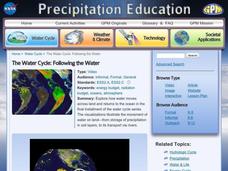NASA
Apollo Moon Soil Radiation Experiment
When a stream of charged particles known as the solar wind careens into the Moon’s surface at nearly 280 miles per second (450 kilometers per second), it enriches it in ingredients that could make water. Planetary scientists Jason McLain...
Curated Video
The Fascinating World of Comets
Learn the key characteristics of comets, including their icy composition, the formation of their tails as they approach the sun, and their historical significance. The video also highlights the role of comets in bringing water and...
Science360
Melting Mountain Glaciers -- Changing Planet
The world's glaciers are shrinking at alarming rates, and many scientists believe it is due to changes in climate. Dr. Lonnie Thompson of Ohio State University and Dr. Douglas Hardy of UMass-Amherst discuss glaciers and how they melt,...
Ancient Lights Media
The Structure of the Atmosphere
Atmosphere Set: 1. This clip examines the chemical composition and the layers of the atmosphere.
Wonderscape
Science Kids: Magnetism and How Magnets Work
This video provides an introduction to magnets and magnetism, explaining how magnets work, their different poles, and their applications in everyday life. It also explores the Earth's magnetic field and its importance, as well as how...
Getty Images
This animation provides a close perspective of the relationship between ice and solar reflectivity.
As glaciers, the polar caps, and icebergs (shown here) melt, less sunlight gets reflected into space. Instead, the oceans and land absorb the light, thus raising the overall temperature and adding energy to a vicious circle
Curated OER
Radiation
Two types of radiation are discussed in this conversation between a professional and a preteen scientist. Solar rays and galactic cosmic rays are extremely powerful and need to be shielded against when astronauts travel in space....
SciShow
3 Unsolved Moon Mysteries
What do people really know about the moon? Learn about three unsolved moon mysteries: the moon's past magnetic field, lunar sunrises, and what's really inside the moon's craters. An engaging video from the SciShow Space series connects...
American Chemical Society
Do Astronauts Need Sunscreen?
Why don't astronauts all come home with sunburns? It turns out that there are many different sources of radiation exposure for astronauts. A video outlines the radioactive dangers and protective measures astronauts must take.
PBS
The Anatomy of the Sun
Welcome to Sun 101! What better way to gain an understanding of our star than to learn about its anatomy? Physical science scholars peer inside to discover the inner workings of the sun through a video and discussion questions. The...
NASA
The Water Cycle: Following the Water
Water that leaves the oceans must eventually return. The animations in the final lesson of the four-part NASA series show the complex path water can take across landforms before returning to the ocean. Approximately one-third of the...
NASA
The Water Cycle: Steaming the Air
How does water vapor move from point A to point B? The second installment in a series of four on the water cycle allows scholars to analyze satellite images to answer this question. The satellite animations show how evaporation and...
Bozeman Science
ESS3D - Global Climate Change
Climate change has severe consequences to the future of our world. Through specific examples, a video instructor explains the causes and outcomes of the changing climate. He also gives advice on how to present the information across...
National Academies of Sciences, Engineering, and Medicine
Solar Influence—Climate Change, Lines of Evidence: Chapter 6
Have scientists considered that the sun heating up might be a cause of global warming? The sixth of seven videos on the factors that affect the climate explains and tests this theory. It includes data collected from satellites, weather...
DoodleScience
Heat Transfer - Radiation
How is it possible that we can feel the heat of a sun that is so far from Earth? Study the type of heat transfer that makes this possible! The video introduces learners to radiation and how it functions when transferring heat.
TED-Ed
Sunlight Is Way Older than You Think
Light travels fast... really fast. But that doesn't mean it moves instantly from its source to whatever object it hits. After watching this video students will understand that once generated in the sun's core,...
Bill Nye
Bill Nye The Science Guy on The Sun
This flick opens by revealing the enormity and extreme heat of the sun through a very old-fashioned cartoon. A solar eclipse is explained by Mr. Nye, and a safe way to examine an image of the sun is demonstrated. That's the extent of...











